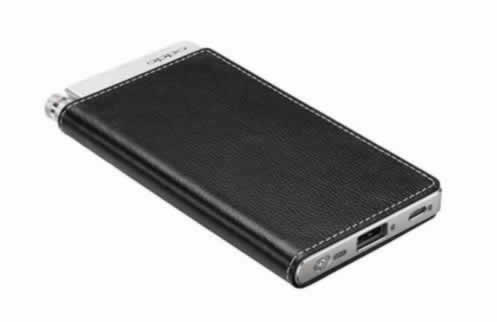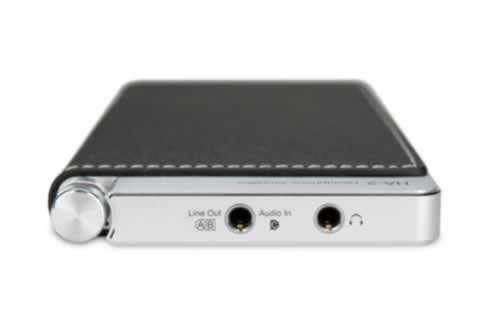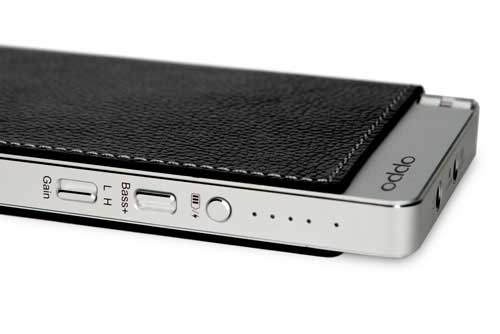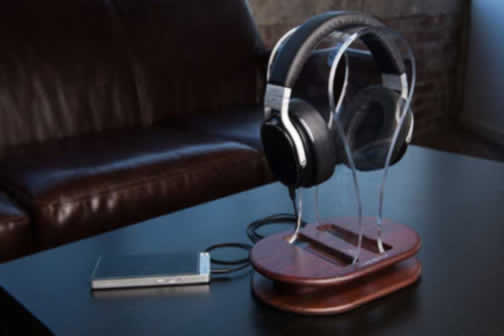|
|
||||
I'd been quite happy with the audio performance I get from my phone, mostly, though I also seek out or create the best quality files I can find before I stuff 'em onto the Samsung so I can ensure optimal audio. Or so I'd thought before OPPO Digital spoiled it all for me with this terrific little unit.
The HA-2 looks and feels elegant, of fine quality. There's a nice leather cover and the aluminum body is classy and feels very solid. The unit is about the size of some smart phones, and it comes with connectors to hook into just about anything you can think of, from iOS and Android devices to PC/Mac. There's even a 3.5 mm jack, which is what my older phone needs; it hooks into the phone's headphone output and while I don't think it's the best way to exploit the HA-2 it works fine anyway – otherwise I wouldn't be gibbering with such delight about the sound the OPPO makes possible.
 Besides all the I/O's, the HA-2 also has two level settings, a high gain designed for driving larger, more power-thirsty headphones (for which it delivers up to 300 mW into 16 Ohms) and a low gain mode for more sensitive phones, such as ear bud-types. I tried it with both, using some fine Bowers and Wilkins and Bose on ear phones for the high gain sessions and the Bose Quiet Comfort 20 noise cancelling ear buds for low gain, and it worked great with both. I preferred using the buds when going out and about, because they're smaller and more portable, but the on ear types are great home-based listening.
Besides all the I/O's, the HA-2 also has two level settings, a high gain designed for driving larger, more power-thirsty headphones (for which it delivers up to 300 mW into 16 Ohms) and a low gain mode for more sensitive phones, such as ear bud-types. I tried it with both, using some fine Bowers and Wilkins and Bose on ear phones for the high gain sessions and the Bose Quiet Comfort 20 noise cancelling ear buds for low gain, and it worked great with both. I preferred using the buds when going out and about, because they're smaller and more portable, but the on ear types are great home-based listening.
OPPO says they mapped the USB volume control commands to the Sabre DAC chip's internal digital volume control and they also included an analog volume control knob on the unit itself. Since the HA-2 effectively has two volume controls, then, (three if you're outputting to an audio system or portable speaker), you may have to play with the various controls to find your favourite listening level. I tended to use the OPPO's knob when using headphones, leaving the phone on a fixed volume (which is very convenient); when outputting the OPPO to an external audio system such as the Bose SoundLink Mini speaker system or car stereos via the vehicles' USB/Auxiliary inputs, I'd leave both the OPPO and the phone on full and use the Bose/car's volume control. Both methods work fine.
The HA-2 also has a bass boost function, like the "loudness" control on some audio components. It works but I prefer leaving it off. To each his own.

The manufacturer says the HA-2 uses hybrid class AB amplification, and its USB DAC supports 384 kHz PCM and DSD256, which are excellent specs. It can also charge mobile devices on the fly, though it kept falling off my pants when I tried that (perhaps I didn't quite understand what they meant by "on the fly"…). The device is rechargeable either via USB or by the included rapid charger, the latter of which only takes about half an hour. A set of green LED's let you know how much charge is left in the unit.
OPPO says the HA-2 actually bypasses the player's internal DAC and amplifier circuit, and replaces your computer's sound card if that's where you're using it. The ESS Sabre DAC that's the heart of the HA-2 is a portable version of the chip OPPO uses in its standalone HA-1 headphone amp and offers high-resolution performance with low noise and distortion.
The HA-2 does an excellent job of upping the audio quality ante of my digital music. I've tried it with my Android phone, my iPad Air, my PC and, as mentioned, even my Bose SoundLink Mini Bluetooth speaker (the auxiliary input bypasses the Bluetooth interface, offering direct connection) and a couple of cars I was reviewing at the time (via aux or USB connections). In all cases, I was impressed mightily with the audio quality. Doing "before and after" A/B testing made it very clear that the OPPO not only works as advertised, but that it works really, really well as far as my ears are concerned. Sound is cleaner and clearer and more involving, channel separation is excellent and the overall sound is such that, if audio excellence is important to you, you'll probably want to order an HA-2 right away.
I listened to a wide variety of tunes, from reference recording quality classical and SACD-based files to MP3, FLAC and high resolution WAV files and came to really love this little device. As I said, I've never found the audio from my phone wanting before, but OPPO saw to it that I'm now spoiled want to take the HA-2 with me wherever I go. Fortunately, the little critter is small enough to pack away easily and will therefore travel very well; I look forward to annoying neighbours when I stay in hotels and fire up the SoundLink Mini in my room.
 The thing works so well that I wondered why OPPO didn't just include storage space (preferably removable) and playback software so the HA-2 could function as a self-contained playback device on its own. So I contacted OPPO Digital, and their VP of Product Development, Jason Liao, told me the HA-2 is designed for "a specific group of target customers who use their smartphones and laptop computers as the main music storage and playback devices." He said this approach allows them to use whatever playback software the customer may be comfortable with, from "the easy-to-use iTunes to specialized high-resolution player apps. It also supports the use of streaming applications such as Spotify, iTunes Radio, and high-resolution streaming such as TIDAL." That makes sense, though I'd still love to see such a device from OPPO, because their stuff is just so darn good. Alas, Mr. Liao also told me OPPO isn't planning to develop a portable music player at this time.
The thing works so well that I wondered why OPPO didn't just include storage space (preferably removable) and playback software so the HA-2 could function as a self-contained playback device on its own. So I contacted OPPO Digital, and their VP of Product Development, Jason Liao, told me the HA-2 is designed for "a specific group of target customers who use their smartphones and laptop computers as the main music storage and playback devices." He said this approach allows them to use whatever playback software the customer may be comfortable with, from "the easy-to-use iTunes to specialized high-resolution player apps. It also supports the use of streaming applications such as Spotify, iTunes Radio, and high-resolution streaming such as TIDAL." That makes sense, though I'd still love to see such a device from OPPO, because their stuff is just so darn good. Alas, Mr. Liao also told me OPPO isn't planning to develop a portable music player at this time.
Connecting your playback device to the HA-2 does end up creating a bit of a Rube Goldberg-type beast where your device and the HA-2 lie together like newlyweds, though held together by rubber bands rather than banns and with wires twisting between them. But this is a mere quibble about what's actually a really great piece of equipment. And as Mr. Liao also noted, "we know that it is clumsy to carry two devices, either a smartphone and a DAC/headphone amp, or a smartphone and a portable player. This is why we try to make the HA-2 as small as we can, and add a mobile power bank function to make it more useful for smartphone users." He said the elastic bands that come in the package are meant only as a way to get users started and that "as the product gets more acceptance, I am sure we or some third-party will start working on better bundling solutions." He's undoubtedly right – and I must admit that I'd rather have to fight with wires and elastic bands than have no HA-2.
One thing the HA-2 won't do is make a silk purse out of a sow's ear when it comes to resuscitating substandard digital files. This isn't an issue with the OPPO, of course; it's the nature of digital music files and is why I try to ensure the files on my device are of as good quality as they can be. It's a fact of musical life: every time I upgrade my audio equipment the new stuff not only makes the good-sounding stuff even better - often spectacularly so, as in this case - but it also makes the shortcomings of the source material more audible, whether scratches on vinyl record, substandard digital files, DVD's or whatever. It's a trade-off audiophiles have learned to accept over the years and is undoubtedly one of the reasons (besides enhancing their profitability) the record companies keep reissuing their old catalogue titles remastered, remixed, or "re-whatevered" every time a new, higher end audio format comes out. So if you want the HA-2 to work best, feed it quality files.
As great as OPPO's HA-2 is, it isn't for everyone – as Mr. Liao noted it's targeted at a specific customer base. To back up this point, I showed the HA-2 to some people who basically went "huh?" when I told them what it is. These were hardly Luddites, but they weren't audiophiles and couldn't imagine spending $299 for such a device.
On the other hand, however, if you're anal about audio, you might find the HA-2 a real breath of fresh air.
Copyright 2015 Jim Bray
TechnoFile.com
Jim Bray's columns are available through the TechnoFile Syndicate.

 OPPO Digital's HA-2 a high end audio solution to low end portable sound
OPPO Digital's HA-2 a high end audio solution to low end portable sound